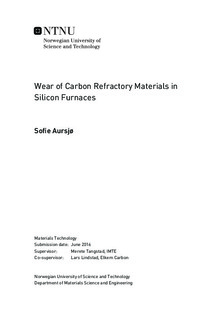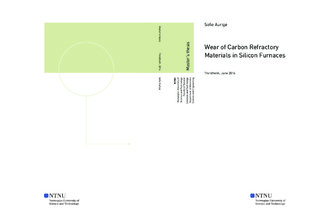| dc.description.abstract | The goal of this thesis was to investigate the internal morphology of different types of lining prepared with different installation techniques and different binders, and to see how the internal morphology affects the different wear mechanisms of the carbon lining. Part of the thesis was also to evaluate how differences in the experimental setup such as choice of furnace, temperature profile and addition of slag influenced the amount of silicon intrusion into the sample, and to compare the experimental setups with conditions found in industrial furnaces.
It was discovered that samples prepared with a layered morphology had density variations depending on the layers, and the density at the top of the layers was significantly higher than the density in the bottom of the layers. The difference in density increased as the layer thickness increased. It was also noted that the lining installation tool affected the degree of grain crushing, and that the amount of cracks in the samples depended on the choice of binder phase.
After exposure to silicon and slag, it was determined that intrusion first occurred in the most porous areas, and that intrusion of silicon led to conversion of the carbon lining to silicon carbide. It was noted that the binder phase was converted first, but that a topo chemical reaction also occurred with the anthracite grains. The maximum intrusion depth of the slag was 0.5 mm while the silicon intruded all the way into the center of the sample, and no reaction occurred between the lining and the slag. Conversion to silicon carbide was also observed in some of the samples without intrusion, and this conversion is assumed to have occurred as a reaction between SiO(g) formed in the furnace during heating, and the carbon lining.
It was observed that the conversion to silicon carbide could be detrimental for the lining, as strings and pieces of silicon carbide was found in the slag surrounding the surface, detached from the rest of the lining. This means that converted lining could be eaten away by the slag over time, which would alter the lining properties and possibly ruin the lining performance. | |

